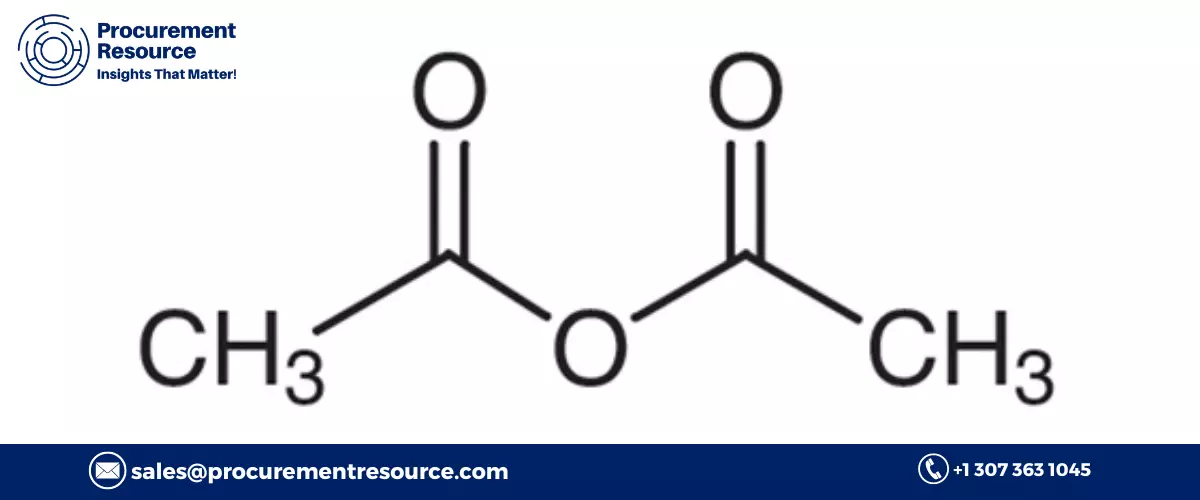Acetic Anhydride is a widely popular chemical compound that finds its applications in various end-user industries, making its procurement crucial. In the following blog, we will uncover the market dynamics of the product with the factors directly impacting the market.
Acetic Anhydride: What is it?
Acetic anhydride (C4H6O3C4H6O3), a clear colourless liquid, is an organic compound that is an acyclic carboxylic anhydride. It has a strong vinegar-like smell and a sour taste with a flash point of 129 °F. Acetic anhydride density is heavier than water. It is derived from acetic acid and is composed of four carbons, six hydrogens and three oxygens. It is fully miscible with diethyl ether and is easily liquefied in typical organic solvents. It can react with alcohol and is a great solvent for several organic and inorganic products. It has the function of a metabolite and a reagent.
Product Application
Acetic anhydride finds significant application as a chemical intermediate and as a catalyst to facilitate the production of phthalic acid, maleic anhydride, and 1-hexene monomer. It can be used in biological processes for generating several products as a carrier of nutrients that delivers hormones into living organisms’ cells. In addition, it can also be used to manufacture vinyl acetate polymer for making Aspirin in the production of polyurethane and acetic acid. Furthermore, it is also employed in semiconductor production. Also, its other uses include Alkene hydrolysis, lubricant manufacturing as well as a solvent for dissolving compounds or breaking down a compound into simpler forms.
Major Players
The following are the key players in the global acetic anhydride market that contribute to various capacity expansions, market shares, plant turnarounds, latest developments, mergers, and acquisitions:
- Sahara International Petrochemical Company
- Jubilant Life Sciences Ltd.
- Eastman Chemical Company
- Daicel Corporation
- Saudi International Petrochemical Company (Sipchem)
- PetroChina Company Limited
- Celanese Corporation
Three processes employed for the production of Acetic anhydride are:
- Eastman process: Production of acetic anhydride using the Eastman process involves a blend of methyl acetate and carbon monoxide being reacted in the presence of a rhodium catalyst along with one or more proponents.
- Production of Acetic Anhydride via a two-step process: The process begins with the production of ketene after acetone is pyrolyzed and later ends with its reaction with acetic acid to finally give Acetic Anhydride.
- Production of Acetic Anhydride through ketene process: In the process, ketene is formed by dehydrating Acetic acid, which in a cracking furnace gets reacted with acetic acid in the presence of triethyl phosphate as the catalyst, finally resulting in the production of acetic anhydride.
Acetic Anhydride Price Insights
Europe
Countries in Europe were met with the threatening financial condition of stagflation, in which the dynamics of demand plunged while there was a substantial rise in inflation rates. The market dynamics of Acetic Anhydride persisted to be volatile as the material produced domestically was priced high up owing to the burly production cost as a result of high energy prices. Meanwhile, prices of imported materials were significantly lower in comparison to materials produced domestically. The elevated prices of energy and lower demand from the downstream construction sector indicated that manufacturers were quick to cut operation rates.
North America
Prices of Acetic Anhydride persistently plunged over the three months of the 2022 penultimate quarter on the back of stable to weak demand and weak cost support dynamics. Meanwhile, prices of the feedstock Acetic acid fell sharply as the prices of upstream Methanol relaxed in the third quarter, which worsened the cost pressure over Acetic anhydride. At the same time, prices of energy feedstock increased, yet they impacted the Acetic anhydride prices to a certain extent. According to the market players, abundant levels of supply and inventory for catering for the domestic demand are there, whereas the intake from the overseas market stayed flat due to frail volume offtakes from the market in Europe.
Asia Pacific
Prices of Acetic Anhydride dipped during the quarter due to feeble feedstock prices and idle demand in both the domestic and international markets. The Acetic acid Feedstock prices plunged over the quarter, which relaxed the general production cost. At the same time, due to continuous lockdowns in the country to counter the covid pandemic, demand dynamics stayed under pressure. The construction industry’s performance, ridden with debt, has been unsatisfactory, and the volume of offtakes stayed hushed. Meanwhile, the Northeast Asia and South Asia supply chains persisted in being under extreme stress as typhoons led to a halt in port activities in Japan, China, and South Korea.
Acetic anhydride finds significant application as a chemical intermediate, as a catalyst, in biological processes, to manufacture vinyl acetate polymer, in semiconductor production, in Alkene hydrolysis, Lubricant manufacture, as well as a solvent making it an ideal chemical compound for many end-uses. Owing to these uses, its procurement is vital. Hence, it is essential to understand the factors affecting its market dynamics, including rising rates of inflation, high energy prices, low downstream demand, and declining feedstock prices.

